The Integrated Chemistry Systems Market is estimated to be valued at USD 2.1 billion in 2025 and is projected to reach USD 3.8 billion by 2035, registering a compound annual growth rate (CAGR) of 6.0% over the forecast period.
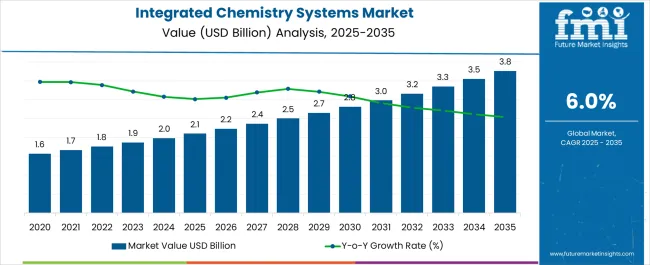
| Metric | Value |
|---|---|
| Integrated Chemistry Systems Market Estimated Value in (2025 E) | USD 2.1 billion |
| Integrated Chemistry Systems Market Forecast Value in (2035 F) | USD 3.8 billion |
| Forecast CAGR (2025 to 2035) | 6.0% |
The Integrated Chemistry Systems market is witnessing robust growth, driven by the increasing adoption of advanced chemical analysis technologies across research, industrial, and academic applications. Rising demand for precise, efficient, and automated chemical testing solutions is supporting the expansion of integrated chemistry platforms. These systems combine multiple analytical techniques and workflows into a single unit, improving throughput, reducing errors, and enhancing reproducibility.
Technological advancements such as automation, miniaturization, and real-time data acquisition are further accelerating adoption. Growing investments in pharmaceutical research, environmental monitoring, and materials development are driving the need for high-performance systems that can support complex experimental designs. The ability to streamline laboratory operations, reduce operational costs, and comply with regulatory standards is strengthening the market appeal of integrated chemistry systems.
As organizations increasingly prioritize innovation, efficiency, and data-driven experimentation, the market is expected to maintain steady growth, supported by continuous improvements in system capabilities, software integration, and high-precision instrumentation The overall trend toward laboratory automation and intelligent analytical solutions is shaping long-term market dynamics.
The integrated chemistry systems market is segmented by application, product types, end users, and geographic regions. By application, integrated chemistry systems market is divided into Chemical Analysis, Immunoassay, and Full Bioassay. In terms of product types, integrated chemistry systems market is classified into Photo Electrochemical Systems and Biological Integrated Chemical Systems. Based on end users, integrated chemistry systems market is segmented into Research Laboratories, Biopharmaceutical Companies, and Forensic Laboratories. Regionally, the integrated chemistry systems industry is classified into North America, Latin America, Western Europe, Eastern Europe, Balkan & Baltic Countries, Russia & Belarus, Central Asia, East Asia, South Asia & Pacific, and the Middle East & Africa.
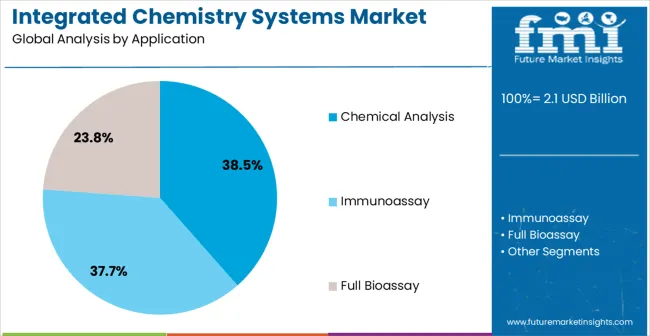
The chemical analysis application segment is projected to hold 38.5% of the market revenue in 2025, establishing it as the leading application. Growth in this segment is being driven by the increasing demand for accurate, reproducible, and high-throughput chemical testing across pharmaceutical, industrial, and academic research. Integrated chemistry systems enable simultaneous multi-parameter analysis, improving efficiency while reducing manual handling and human error.
These systems provide automated sample preparation, measurement, and data interpretation, allowing laboratories to accelerate research cycles and meet stringent regulatory compliance requirements. The adoption of advanced analytical techniques, including spectroscopy, chromatography, and electrochemical analysis, enhances the precision and reliability of chemical studies.
Rising emphasis on quality assurance, process optimization, and safety monitoring further supports the use of these systems As laboratories face growing pressure to deliver faster, high-quality results, chemical analysis applications are expected to continue driving the market, supported by innovations in system integration, software control, and analytical throughput.
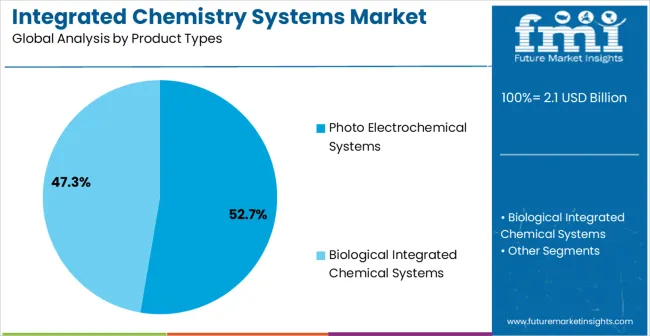
The photo electrochemical systems product type segment is anticipated to account for 52.7% of the market revenue in 2025, making it the leading product category. Its growth is being driven by the increasing demand for systems capable of converting light energy into chemical energy for applications such as solar fuel generation, water splitting, and photocatalytic studies. These systems provide high-precision control over experimental conditions and integrate multiple measurement techniques for enhanced data reliability.
Advancements in electrode materials, light source optimization, and automated control features have further strengthened their performance and usability. Integration with data acquisition software allows real-time monitoring and analysis, improving experimental reproducibility and efficiency.
The ability to reduce energy consumption, streamline laboratory workflows, and enhance research outcomes has accelerated adoption among academic, industrial, and governmental research institutions As the focus on renewable energy research and sustainable chemical processes increases, the photo electrochemical systems segment is expected to maintain its leadership in the market, supported by technological innovation and growing demand for advanced experimental platforms.
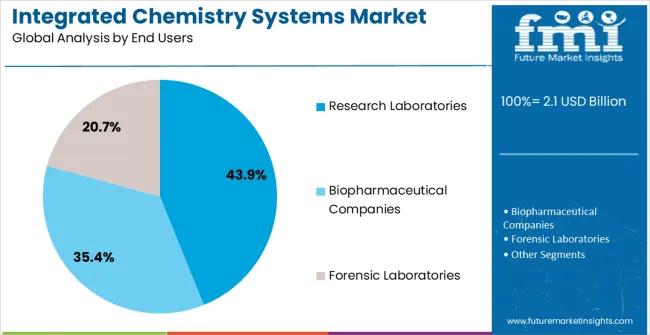
The research laboratories end-user segment is projected to hold 43.9% of the market revenue in 2025, establishing it as the leading end-use category. Growth in this segment is being driven by the need for high-precision, automated, and integrated analytical platforms to support diverse research objectives. Laboratories engaged in pharmaceutical, materials, environmental, and chemical research are increasingly adopting integrated chemistry systems to enhance experimental throughput, accuracy, and reproducibility.
These systems enable laboratories to consolidate multiple analytical workflows, reduce operational complexity, and optimize resource utilization. Rising investments in research and development, coupled with a focus on innovation and compliance with regulatory standards, are further supporting adoption.
The ability to generate real-time data, facilitate multi-parameter analysis, and support high-throughput experimentation makes integrated chemistry systems indispensable for research laboratories As the demand for efficient, accurate, and scalable analytical solutions continues to grow, research laboratories are expected to remain the largest end-user segment, reinforcing their central role in driving market expansion and technology adoption.
Integrated Chemical Systems takes the discussion on Nano systems and nanotechnology, out of the area of assumption and into the real world. Integrated chemical systems are defined as multiphase systems, heterogeneous concerning several different components including membranes, catalysts, polymers, and semiconductors arranged and designed for specific functions or to carry out specific reactions or processes.
Often the different mechanisms will be prepared physically and will show responsive effect. Integrated chemistry systems are associated with large compound structures normally have graded assemblies that is collected from minor parts that are in opportunity to build from simpler and smaller ones, finally down to units with molecular and atomic dimensions.
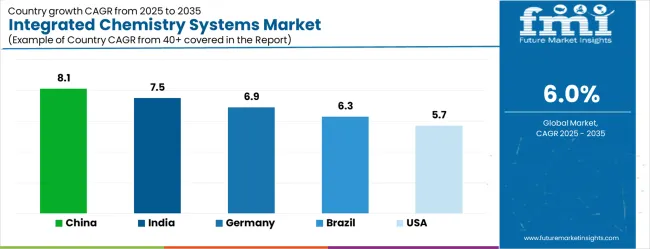
| Country | CAGR |
|---|---|
| China | 8.1% |
| India | 7.5% |
| Germany | 6.9% |
| Brazil | 6.3% |
| USA | 5.7% |
| UK | 5.1% |
| Japan | 4.5% |
The Integrated Chemistry Systems Market is expected to register a CAGR of 6.0% during the forecast period, exhibiting varied country level momentum. China leads with the highest CAGR of 8.1%, followed by India at 7.5%. Developed markets such as Germany, France, and the UK continue to expand steadily, while the USA is likely to grow at consistent rates. Japan posts the lowest CAGR at 4.5%, yet still underscores a broadly positive trajectory for the global Integrated Chemistry Systems Market. In 2024, Germany held a dominant revenue in the Western Europe market and is expected to grow with a CAGR of 6.9%. The USA Integrated Chemistry Systems Market is estimated to be valued at USD 733.1 million in 2025 and is anticipated to reach a valuation of USD 733.1 million by 2035. Sales are projected to rise at a CAGR of 0.0% over the forecast period between 2025 and 2035. While Japan and South Korea markets are estimated to be valued at USD 108.8 million and USD 63.2 million respectively in 2025.
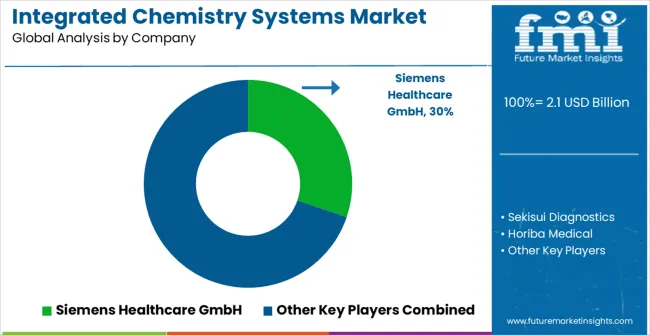
| Item | Value |
|---|---|
| Quantitative Units | USD 2.1 Billion |
| Application | Chemical Analysis, Immunoassay, and Full Bioassay |
| Product Types | Photo Electrochemical Systems and Biological Integrated Chemical Systems |
| End Users | Research Laboratories, Biopharmaceutical Companies, and Forensic Laboratories |
| Regions Covered | North America, Europe, Asia-Pacific, Latin America, Middle East & Africa |
| Country Covered | United States, Canada, Germany, France, United Kingdom, China, Japan, India, Brazil, South Africa |
| Key Companies Profiled | Siemens Healthcare GmbH, Sekisui Diagnostics, Horiba Medical, Erba Diagnostics, and ELITech Group |
The global integrated chemistry systems market is estimated to be valued at USD 2.1 billion in 2025.
The market size for the integrated chemistry systems market is projected to reach USD 3.8 billion by 2035.
The integrated chemistry systems market is expected to grow at a 6.0% CAGR between 2025 and 2035.
The key product types in integrated chemistry systems market are chemical analysis, immunoassay and full bioassay.
In terms of product types, photo electrochemical systems segment to command 52.7% share in the integrated chemistry systems market in 2025.






Full Research Suite comprises of:
Market outlook & trends analysis
Interviews & case studies
Strategic recommendations
Vendor profiles & capabilities analysis
5-year forecasts
8 regions and 60+ country-level data splits
Market segment data splits
12 months of continuous data updates
DELIVERED AS:
PDF EXCEL ONLINE
Integrated Traffic System Market Size and Share Forecast Outlook 2025 to 2035
Integrated Mineral Analyzer Market Size and Share Forecast Outlook 2025 to 2035
Integrated Motor Protector Market Size and Share Forecast Outlook 2025 to 2035
Integrated Universal Integrated Circuit Card (iUICC) Modules Market Size and Share Forecast Outlook 2025 to 2035
Integrated SIM (iSIM) Market Size and Share Forecast Outlook 2025 to 2035
Integrated 3D Radar Market Size and Share Forecast Outlook 2025 to 2035
Integrated UPS Market Size and Share Forecast Outlook 2025 to 2035
Integrated Labeling System Market Size and Share Forecast Outlook 2025 to 2035
Integrated Quantum Optical Circuits Market Size and Share Forecast Outlook 2025 to 2035
Integrated Graphics Chipset Market Analysis by Device Type, Industry Vertical, and Region – Growth, Trends, and Forecast from 2025 to 2035
Integrated Food Ingredients Market Analysis -Size, Share & Forecast 2025 to 2035
Integrated Gas System Market Growth – Trends & Forecast 2025 to 2035
Integrated Passive Devices (IPDs) Market
Integrated CMOS Tri-gate Transistor Market
AI-Integrated Blood Analyzers Market Analysis - Size, Share, and Forecast Outlook 2025 to 2035
Drug Integrated Polymer Fibers Market Size and Share Forecast Outlook 2025 to 2035
RFID-Integrated Smart Packaging Market Analysis - Size, Share, and Forecast Outlook 2025 to 2035
Fully Integrated Dishwasher Market Size and Share Forecast Outlook 2025 to 2035
Power Integrated Modules Market Trends – Growth & Forecast through 2034
Memory Integrated Circuits (IC) Market Growth - Trends & Forecast 2025 to 2035

Thank you!
You will receive an email from our Business Development Manager. Please be sure to check your SPAM/JUNK folder too.
Chat With
MaRIA